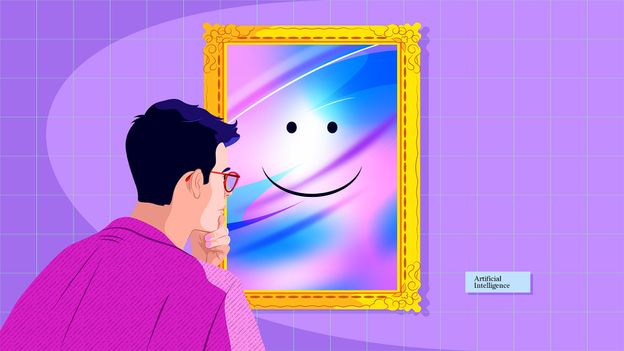Is AI Redefining Art? Exploring the Intersection of Creativity and Technology
Artificial intelligence is making significant strides in the realm of creativity, producing everything from stunning digital paintings to intricate sculptures that can fetch thousands of dollars at auction. As AI continues to push the boundaries of artistic expression, many are left wondering – do we need to rethink our understanding of what art truly is?
A New Kind of Artist: Meet Ai-Da
In a cozy drawing room far from the bustling city, I witnessed a unique artistic process unfold. There, an artist dressed in dungarees was not your average painter; she was Ai-Da, the world’s first humanoid robot artist. Built to create and provoke thought about the nature of creativity, Ai-Da questions the very essence of art and introduces a new perspective on who qualifies as an artist.
As Ai-Da glides her pen across the canvas, forming an abstract self-portrait, it raises a provocative question: Are algorithms and robotic entities like Ai-Da the future of creativity or do they represent a threat to human artists?
Challenging Norms: The Legacy of Duchamp
To understand the implications of AI in art, we can draw parallels to a time over a century ago when Marcel Duchamp submitted a urinal as art, challenging conventional norms. His argument was revolutionary: art could be anything the artist declared it to be. Fast forward to today, and similar debates arise in light of AI-generated artwork. If Duchamp’s urinal and Tracey Emin’s unmade bed could be called art, what’s stopping us from accepting the creations of a generative algorithm?
Historian Alice Helliwell from Northeastern University London raises an interesting point about the evolving definition of art. "Historically, the way we understand art has shifted," she explains. “It’s hard to see why something generated by an algorithm can’t be seen as art.”
The Role of AI in Artistic Evolution
Tech innovations often lead to fears of obsolescence. However, proponents like mathematician Marcus du Sautoy argue that AI could nurture creativity rather than crush it. “AI might help us to stop behaving like machines and reignite our creative spirit,” he suggests. The historical context is rich – consider how photography once threatened traditional painting but instead propelled the rise of modern art.
In fact, Ai-Da’s work exemplifies how technology can revolutionize the creative process. The robot’s creators, Aidan Meller and Lucy Seal, envision her as a reflection of societal concerns about AI encroaching on human roles. By showcasing Ai-Da’s art in prominent galleries, they invite us to engage with and reflect upon these fears.
Collaboration: Humans and Machines
The interaction between human creativity and AI is gaining traction, as some artists view AI as a fresh tool for expression rather than a rival. Artists like Sougwen Chung are collaborating with algorithms that learn from their pieces, pushing the boundaries of their own creativity.
Margaret Boden, a cognitive science researcher, offers a definition of creativity that resonates: generating ideas that are new, valuable, and surprising. Based on this, some believe that works produced by machines like Ai-Da could indeed be considered creative.
The Complexity of Authorship
As we explore the creative output of AI, we also confront complex issues surrounding authorship and ownership of ideas. With artists like Holly Herndon advocating for greater transparency, there is a push for ethical considerations in how AI is trained and how it utilizes the works of human creators.
Furthermore, the process involved in machine learning – where code evolves through exposure to data – may also be viewed as a creative act. Du Sautoy points out that the end product of learning can diverge significantly from the initial input, raising questions about the originality of AI-generated art.
Are AI Creations ‘Real’ Art?
While discussing the essence of creativity, it becomes clear that intent plays a profound role. No AI, regardless of how advanced, possesses the true intent behind an artwork. Yet, as philosopher Helliwell posits, the absence of conscious self-awareness does not necessarily invalidate AI-generated pieces as art.
This leads us to consider the artistry apparent in the natural world. Animals like bower birds and pufferfish exhibit creativity that may not stem from a conscious intention to create art, yet their actions are intricate enough to be admired, raising questions about the inherent definitions of creativity and artistry.
The Future of Art and AI
With AI artworks increasingly displayed in prestigious campaigns, the art world is witnessing a transformation. Eva Jäger, a curator in London, believes that traditional and AI-driven art can coexist, encouraging meaningful collaborations that explore the depths of creativity and expression.
"Understanding the practice behind a piece of art is crucial,” she says. “The process gears us towards innovation rather than just the aesthetic value.”
As we step into this uncharted territory defined by machines and algorithms, one thing is certain: creativity is not a finite process. Weaving together human experiences and machine learning may lead us to exciting new horizons of artistic expression.
In conclusion, as we navigate this dynamic intersection of art and AI, Diana Helliwell affirms that creativity is a continuum where all artists, regardless of their medium, draw from the well of human and artistic history. Ultimately, art is in the eye of the beholder, and who knows what the future holds?
The AI Buzz Hub team is excited to see where these breakthroughs take us. Want to stay in the loop on all things AI? Subscribe to our newsletter or share this article with your fellow enthusiasts!




